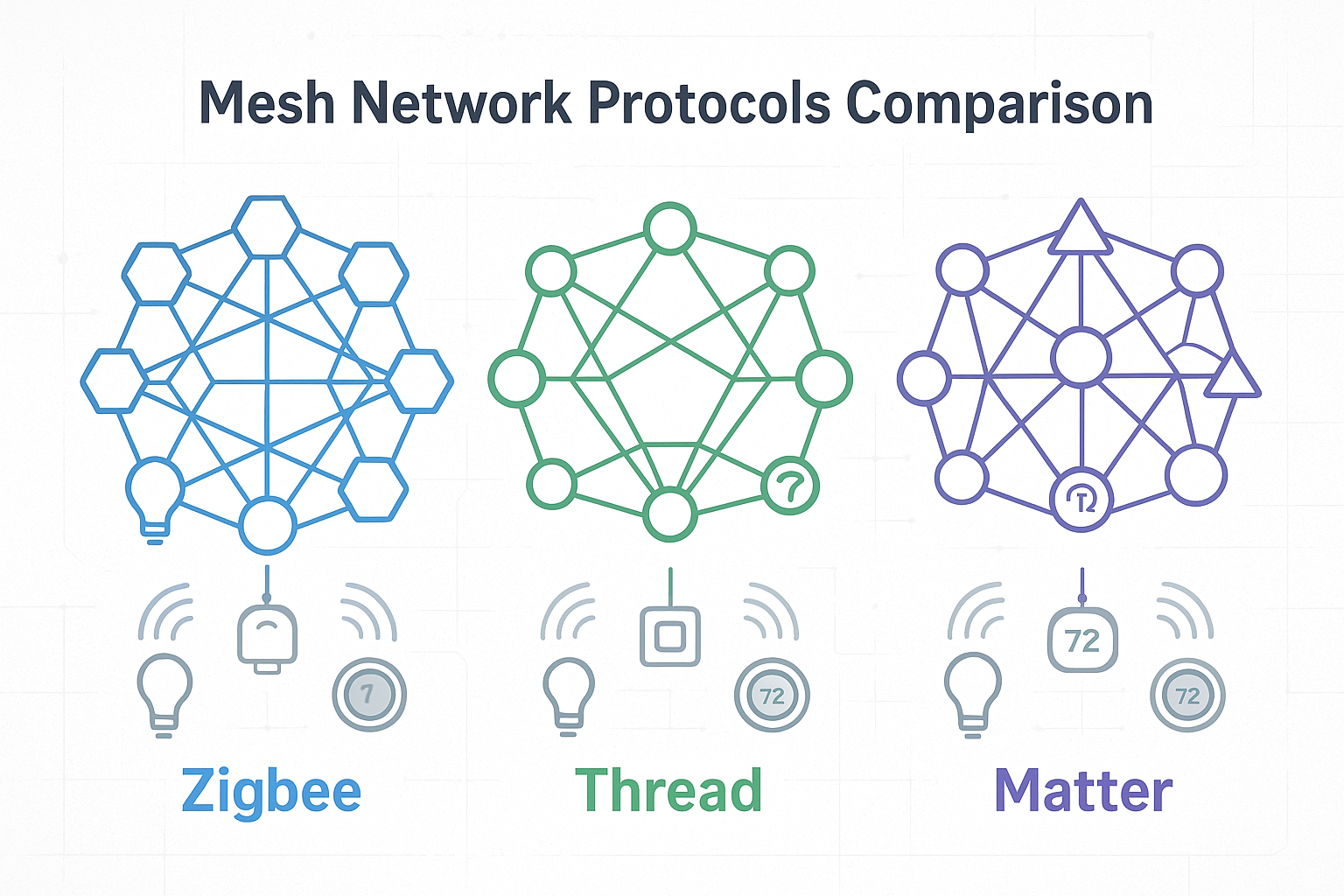Mesh Network Protocols: Zigbee vs Thread vs Matter Compatibility
Compare Zigbee vs Thread vs Matter mesh network protocols. Learn compatibility, features & best smart home protocol for your IoT devices in 2025.

The world of smart home technology is rapidly evolving, and at the heart of this revolution are mesh network protocols that enable seamless device communication. Understanding these protocols is crucial for anyone looking to build a reliable and efficient smart home ecosystem. In this comprehensive guide, we’ll explore the three major mesh network protocols – Zigbee, Thread, and Matter – and help you understand their compatibility, strengths, and ideal use cases.
What Are Mesh Network Protocols?
Mesh network protocols form the backbone of modern smart home connectivity. Unlike traditional point-to-point connections, mesh networks create a web of interconnected devices where each device can communicate with multiple others, creating multiple pathways for data transmission. This redundancy ensures that if one device fails, the network automatically finds alternative routes to maintain connectivity.
These wireless communication standards enable Internet of Things (IoT) devices to work together efficiently while consuming minimal power. The mesh topology allows for self-healing networks that can adapt to changes in device availability, making them ideal for home automation systems where reliability is paramount.
Understanding Zigbee Protocol
Zigbee stands as one of the most established mesh network protocols in the smart home industry. Developed by the Zigbee Alliance, this low-power wireless standard operates on the IEEE 802.15.4 specification and uses the 2.4 GHz frequency band globally, with additional regional frequencies available.
Key Features of Zigbee
The Zigbee protocol offers several compelling advantages for smart home implementations. Its low power consumption allows battery-operated devices to run for months or even years without replacement. The protocol supports up to 65,000 devices on a single network, making it scalable for large installations.
Zigbee’s mesh networking capabilities ensure robust connectivity through automatic route discovery and self-healing properties. When a device is removed or fails, the network automatically reconfigures to maintain optimal communication paths. This resilience makes Zigbee particularly suitable for critical home automation applications.
Zigbee Applications and Devices
Common Zigbee applications include smart lighting systems, security sensors, thermostats, and door locks. Major manufacturers like Philips Hue, Samsung SmartThings, and Amazon Echo Plus have adopted Zigbee for their smart home ecosystems. The protocol’s maturity and widespread adoption mean users have access to a vast ecosystem of compatible devices.
Exploring Thread Protocol
Thread represents a newer approach to mesh networking, developed by the Thread Group consortium. Built on IPv6 and 6LoWPAN standards, Thread operates exclusively on the 2.4 GHz band and focuses on providing secure, reliable connectivity for smart home devices.
Thread Protocol Advantages
Thread’s architecture offers several unique benefits over traditional mesh network protocols. Its IP-based foundation makes it naturally compatible with existing internet infrastructure, simplifying network management and device integration. The protocol includes enterprise-grade security features with AES encryption and secure commissioning processes.
One of Thread’s standout features is its ability to connect directly to the internet without requiring proprietary gateways or hubs. This eliminates single points of failure and reduces the complexity of smart home installations. Thread networks can self-form and self-heal, adapting to changes in network topology automatically.
Thread Ecosystem and Support
Major technology companies including Google, Apple, and Amazon have embraced Thread for their smart home platforms. Google Nest devices, Apple HomePod mini, and select Amazon Echo devices include Thread support. This backing from industry leaders suggests strong future growth potential for Thread adoption.
Matter: The Universal Standard
Matter, formerly known as Project CHIP (Connected Home over IP), represents an ambitious attempt to create a universal smart home standard. Developed by the Connectivity Standards Alliance, Matter aims to ensure interoperability between devices from different manufacturers regardless of the underlying transport protocol.
How Matter Works
Matter functions as an application layer protocol that can run over various transport technologies, including Thread, Wi-Fi, and Ethernet. This flexibility allows manufacturers to choose the most appropriate underlying technology while maintaining compatibility with Matter-certified devices from other brands.
The protocol uses a common data model and device types, ensuring that a Matter-certified light bulb from one manufacturer can work seamlessly with a Matter-certified hub from another. This interoperability addresses one of the biggest pain points in current smart home deployments.
Matter Implementation and Benefits
Matter certification ensures devices meet specific security, reliability, and interoperability standards. The protocol supports local control, reducing dependence on cloud services and improving response times. Voice assistants from Google, Amazon, and Apple all support Matter, enabling unified voice control across different ecosystems.
Zigbee vs Thread: Technical Comparison
When comparing Zigbee and Thread mesh network protocols, several technical differences emerge that influence their suitability for different applications.
Network Architecture Differences
Zigbee uses a coordinator-based architecture where one device serves as the network coordinator, managing the overall network topology. Thread employs a distributed approach with multiple border routers that can provide internet connectivity, eliminating single points of failure.
Both protocols support self-healing mesh capabilities, but Thread’s distributed architecture provides greater resilience. Zigbee networks require careful planning to ensure adequate coordinator coverage, while Thread networks can adapt more dynamically to changing conditions.
Power Consumption and Range
Both protocols are designed for low-power operation, but their power profiles differ slightly. Zigbee devices can achieve extremely long battery life, with some sensors operating for years on a single battery. Thread devices also offer excellent power efficiency, though the IP-based communication may consume slightly more power in some scenarios.
Range characteristics are similar between the protocols, with typical indoor ranges of 30-100 feet depending on construction materials and interference. Both protocols extend range through mesh networking, allowing distant devices to communicate through intermediate nodes.
Protocol Compatibility and Interoperability
Understanding compatibility between mesh network protocols is crucial for planning smart home deployments. Each protocol has distinct characteristics that affect how devices can work together.
Zigbee and Thread Compatibility
Zigbee and Thread are not directly compatible at the protocol level. Devices designed for one protocol cannot communicate directly with devices using the other. However, many smart home hubs and gateways support multiple protocols, allowing mixed deployments.
Bridge devices can provide some level of interoperability by translating between protocols, though this adds complexity and potential points of failure. The most seamless experience comes from choosing devices that support the same underlying protocol.
Matter as a Unifying Layer
Matter addresses compatibility challenges by providing a common application layer that can work over different transport protocols. A Matter-certified device using Thread can work with a Matter-certified hub using Wi-Fi, as long as both support the Matter standard.
This approach allows consumers to focus on Matter certification rather than underlying transport protocols. However, Matter is still in early adoption phases, and not all device categories are currently supported.
Choosing the Right Protocol for Your Smart Home
Selecting the appropriate mesh network protocol depends on your specific needs, existing infrastructure, and future expansion plans.
Factors to Consider
Network size is a primary consideration. Zigbee’s support for up to 65,000 devices makes it ideal for large installations, while Thread’s distributed architecture may be better for medium-sized networks that require high reliability. Consider the types of devices you plan to deploy and their power requirements.
Existing ecosystem compatibility is another crucial factor. If you already have a significant investment in devices from a particular manufacturer, choosing a protocol that maximizes compatibility with your existing setup makes sense.
Future-Proofing Your Investment
With Matter gaining momentum, choosing devices that support or can be upgraded to support Matter may provide the best long-term value. Thread’s backing by major technology companies and its IP-based architecture position it well for future growth.
However, Zigbee’s maturity and extensive device ecosystem remain significant advantages. Many established smart home platforms continue to invest heavily in Zigbee support, ensuring ongoing compatibility and feature development.
Implementation Best Practices
Successful mesh network protocol deployment requires careful planning and adherence to best practices.
Network Planning and Design
Start by mapping your space and identifying device locations. Ensure adequate coverage by planning mesh node placement to avoid dead zones. Consider interference sources like Wi-Fi routers, microwaves, and other 2.4 GHz devices when planning your network topology.
For Zigbee networks, ensure your coordinator device is centrally located and has reliable power. Thread networks benefit from multiple border routers for redundancy and coverage optimization.
Security Considerations
All three protocols include robust security features, but proper implementation is crucial. Change default passwords, enable automatic security updates, and regularly review connected devices. Use strong encryption settings and consider network segmentation for sensitive devices.
Matter’s security model includes device attestation and secure commissioning, providing strong protection against unauthorized access. However, the security of your overall network depends on proper configuration and maintenance.
Troubleshooting Common Issues
Understanding common mesh network protocol issues and their solutions can help maintain optimal performance.
Connectivity Problems
Interference from other wireless devices is a common cause of connectivity issues. Use spectrum analysis tools to identify interference sources and adjust channel settings accordingly. Ensure mesh nodes are within range of each other and consider adding additional devices to improve coverage.
Device compatibility issues can arise when mixing different protocol versions or manufacturer implementations. Verify that all devices support the same protocol version and consider firmware updates to resolve compatibility problems.
Performance Optimization
Regular network maintenance improves performance and reliability. Remove unused devices, update firmware regularly, and monitor network health through your hub’s diagnostic tools. Consider mesh network optimization features that automatically adjust routing for optimal performance.
Future of Mesh Network Protocols
The landscape of mesh network protocols continues to evolve rapidly, with several trends shaping future development.
Emerging Technologies
Wi-Fi 6 and upcoming Wi-Fi 7 standards include mesh networking capabilities that may challenge traditional IoT protocols for some applications. However, the power efficiency advantages of Zigbee and Thread remain significant for battery-operated devices.
Edge computing integration is becoming more important, with protocols evolving to support local processing and artificial intelligence capabilities. This trend reduces cloud dependence and improves response times for smart home applications.
Industry Consolidation
The smart home industry is moving toward greater standardization, with Matter leading this effort. While multiple transport protocols will likely coexist, the application layer standardization provided by Matter should reduce compatibility concerns.
Manufacturers are increasingly supporting multiple protocols in their devices, providing consumers with greater flexibility in their smart home deployments. This trend toward multi-protocol support should continue as the technology matures.
Conclusion
Mesh network protocols form the foundation of modern smart home technology, with Zigbee, Thread, and Matter each offering unique advantages. Zigbee provides maturity and extensive device support, Thread offers modern IP-based architecture with strong industry backing, and Matter promises universal interoperability across different transport technologies.
The choice between these protocols depends on your specific needs, existing infrastructure, and future plans. For most users, focusing on Matter-certified devices provides the best long-term compatibility and flexibility. However, established ecosystems built around Zigbee or Thread continue to offer excellent performance and reliability.
As the smart home industry continues to evolve, these mesh network protocols will undoubtedly improve and adapt to new requirements. Understanding their strengths and limitations helps you make informed decisions that will serve your smart home needs both today and in the future. The key is choosing solutions that align with your specific requirements while maintaining flexibility for future expansion and upgrades.











